Seeds that are easy to grow!
Seeds that are Easy to Grow!
Originally published in the Davis Enterprise 04/29/05
Those magic words are the key to gardening with kids.
Unfortunate childhood experiences starting plants from seed usually result from unsuitable indoor growing conditions, or having chosen plants with special germination or growing requirements. Poor germination, weak spindly seedlings, sudden collapse due to fungus attacking the stems--all bound to lead to disappointment, disillusionment with gardening.
Perhaps even years of therapy.
Your indoor environment is terrible for seedlings. It can be a great place to sprout them, but as soon as they're up they'll be much, much happier outdoors. Why? Because sunlight and air movement make the seedlings produce hormones that cause their 'trunks' to get thicker. Indoors they stretch towards the light until they flop over, and produce thinner leaves. So if you sprout them indoors, move the young seedlings outside as soon as possible. Find a sheltered patio or the light shade of a tree. Give them a few days to 'harden' before you transplant them into the ground.
The primary reason for starting seeds indoors is that outdoor nighttime temperatures are too cold. If you just wait until May, most of the plants listed here can be planted directly in the ground. The other reason for starting indoors -- or at least in pots in a safe place -- is that the young seedlings are vulnerable to marauding critters: snails, slugs, earwigs, cutworms, and birds. The seedlings are most vulnerable the first few days after they sprout.
If predation is your problem, various safe pest control measures can be taken:
--Cover the seed bed with a 'seedling blanket,' available at garden shops and hardware stores, which also helps to keep the soil warm.
--Larger seeds can have strawberry baskets inverted over them to keep birds and snails at bay.
--Sluggo ™ is a snail and slug bait made of iron phosphate which is non-toxic to birds, pets, and children.
--Snails and slugs can be kept out of planter boxes by installing a copper barrier--copper mesh or tape--around the outside.
--Earwigs can be drowned in a simple trap made by putting water with a glug of fragrant cooking oil -- preferably corn, peanut, or olive oil for the aroma -- into a can or milk carton.
--Birds can be deterred with Bird Scare Tape, a shiny aluminized tape, tied in streamers to short stakes poked here and there in the seedbed.
'Easy to grow' plants for kids…
….have large seeds which are easy to handle (especially useful with youngsters).
….don't have special disease or pest problems.
….sprout quickly, grow fast, and bloom or produce food young.
Starting seed outdoors.
--Loose soil is important for quick root growth. Turn it, add compost, rake it smooth. Mix in some 'starter fertilizer'--a typical formula will be 5-20-10, or 5-10-10. The first number should be 10 or less.
--Larger seeds are pressed gently into the soil. Smaller seed is usually just 'broadcast' carefully on the surface.
--Most seed should be covered lightly with soil, and the soil should be pressed down gently.
--Water the seedbed thoroughly with a nozzle that makes a gentle rain, then water daily until you see seedlings. A week or so after the seedlings emerge, you can reduce your watering to every other day and water a bit longer each time.
Books recommend thinning seedlings to be a few inches apart, but this rather tedious process isn't necessary in most cases. The exceptions: plants where you're eating the roots--radishes, beets, carrots--will not develop properly if they're too close together. Thin those to 4 - 6" apart.
'Easy-to-grow' plants for all ages:
Beans
Large fast-germinating seeds. Pole beans twine up on a simple support; a teepee made of bamboo poles is fine. 'Scarlet Runner' beans have showy flowers and edible pods. For best edible beans plant Blue Lake, Derby, Romano, Pencil Wax. The old variety Kentucky Wonder does not perform well in hot summers, so it's not a good choice here. For gourmet appetites, try Asparagus (Yardlong) beans.
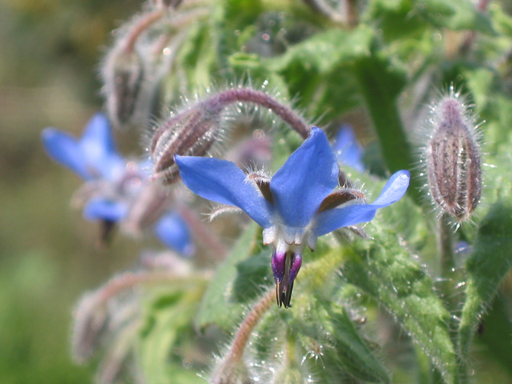 Borage
Borage
Borage
Small seeds, incredibly easy to grow, and reseeds merrily around your garden. The leaves smell like cucumber and are edible. The sky blue flowers are interesting and pretty, and useful for drawing bees into the garden.
Cosmos
Small seeds, requiring warm temperatures to sprout and grow, Cosmos will bloom in just a few weeks from May or June sowing. Flowers are hot shades of pink, red, orange, yellow, and are especially attractive to butterflies. Will reseed itself, but not annoyingly.
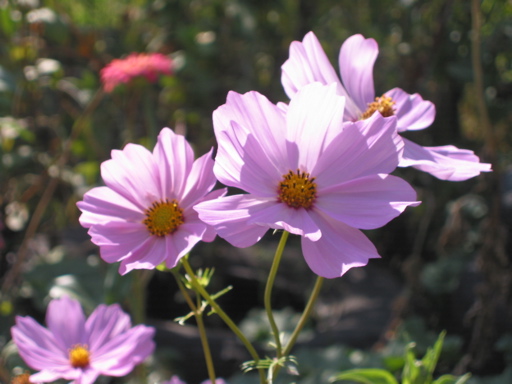 Cosmos
Cosmos
Gourds
Large seeds. These always seem to fascinate younger children. Large seeds sprout quickly. The plant is a vine which will cover a fence or trellis, or grow right up and over other plants in your vegetable garden. The flowers are big and showy, and then gourds develop from about July through fall. Choices include Birdhouse gourd, Luffa sponge gourd, and many odd-shaped ones grown for autumn decorations.
Morning Glory
Medium-size seeds. These have a hard seed coat, and require a little help to get going. Either gently file the seed coat (tedious!), or soak the seeds overnight before planting. Otherwise they may take weeks to sprout. Incredibly vigorous vines with beautiful, showy flowrs that open in morning, close by mid-afternoon. These scramble up on fences, trellises, sheds, shrubs, trees…you get the idea.
Easy-to-grow, hard-go-get-rid-of! Reseeds everywhere, and successive generations usually have pink flowers. The closely related Moonflower opens huge, pure white flowers in the late afternoon and well into the evening. Caution: seeds are poisonous.
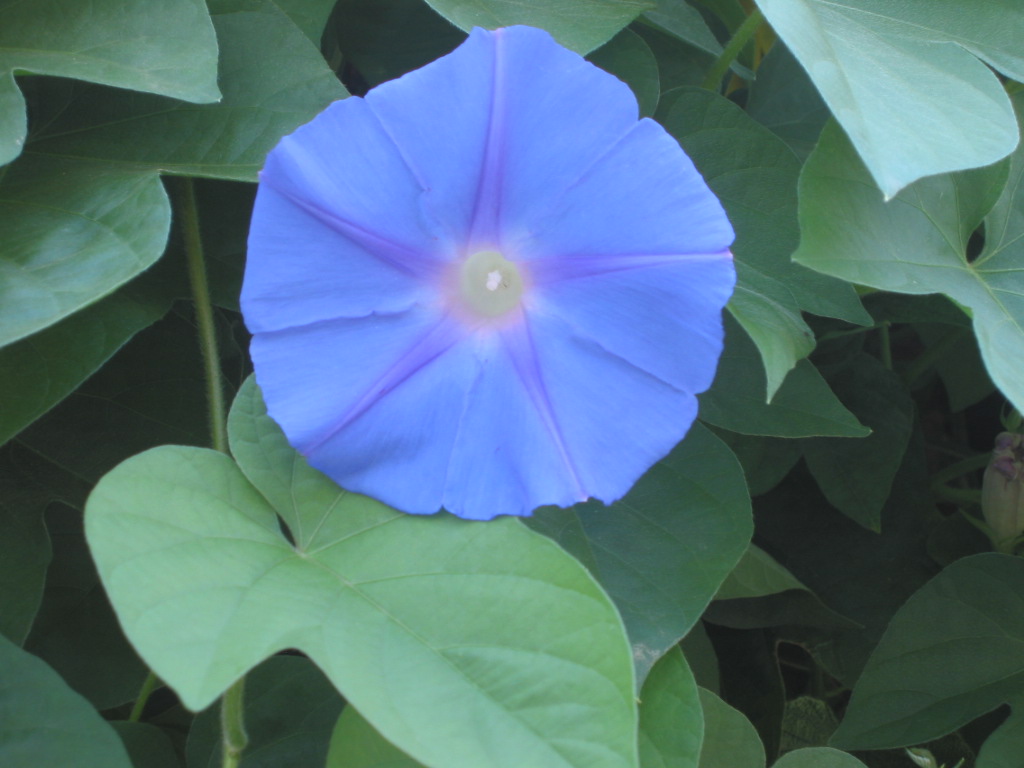 Morning Glory
Morning Glory
Nasturtium
Large seeds, fast germinating, very easy. The only one I've listed which will grow as readily in shade as in sun. Most are short plants to a foot or so, but trailing types can be nudged up onto a trellis to act as a vine (or allowed to trail over a path, recreating the look of Monet's garden). Flowers are edible, peppery.
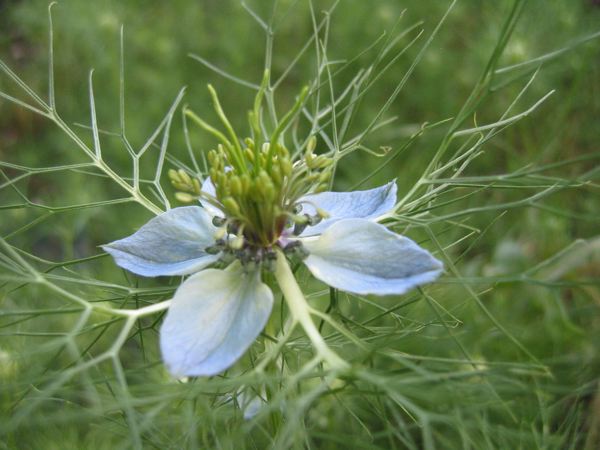 Nigella
Nigella
Nigella
Small seeds. Also called Love-in-a-Mist and Persian Jewels. Just throw the seed out somewhere in your garden and you'll never be rid of this lovely flowering plant. Pretty blue flowers (also available in pink and white) surrounded by lacy foliage; then the puffy seed pods are attractive in their own right. And then they scatter seed far and wide….Butterflies love Nigella.
Sunflowers
Large seeds, germinate quickly, very easy. There are dwarf types (Teddy Bear only gets 2' tall!), and medium-height varieties grown just for the flowers. If you want the big plant with edible seeds, grow Russian Giant (aka Mammoth)--it gets to 10' +! If you don't harvest the seeds in the late summer, the songbirds will enjoy them as winter comes along. And some of them will resprout the next year.
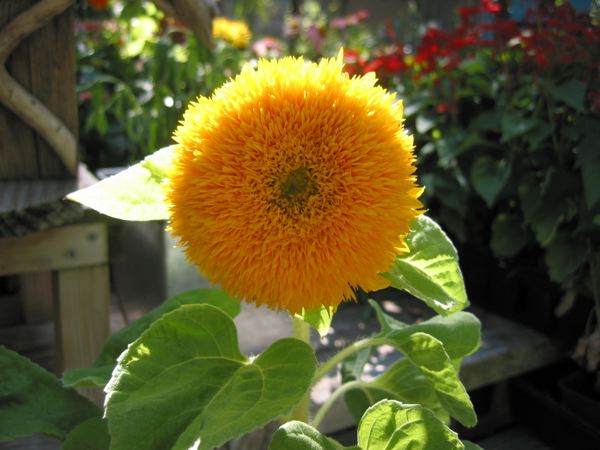 Sunflower Teddy Bear
Sunflower Teddy Bear
Sweet alyssum
Very small seeds, very tiny seedlings, but very easy. Just sow the seed here and there and you'll always have it. Fragrant purple, pink, or white blossoms attract beneficial insects; subsequent generations gradually revert to the white form. Each plant blooms for 10 - 12 weeks; as it's dying, there is a new crop sprouting.
Vegetables and herbs.
Most are simplest to transplant from young starts, but a few sprout quickly and readily.
Basil has very small seeds, but sprouts in just a few days and the seedlings don't need to be thinned. Grows best in full sun, but ok in some shade. For pots, the Spicy Globe variety is a natural dwarf with tiny leaves and great flavor; excellent to keep in a pot near the kitchen door.
Root crops don't transplant well, so they are best sown in place. Carrots take several weeks to germinate due to the presence of an inhibitor in the seed coat. Put the seeds in a bowl, pour boiling water over them, and let them sit overnight to hasten germination. An old trick is to plant carrots and radishes together, since the radishes take only a few weeks to grow and form the edible roots. As you're pulling them out, the carrots are just beginning to grow.
Beets and turnips are incredibly easy to grow, and to my surprise my own kids enjoyed eating them--even raw, in the case of turnips. My grandmother belonged to the New England school of cooking--boil all vegetables to death. It took me a long time to learn that beets don't have to be squishy and turnips don't have to be mashed. The fresher and less cooked the better, in most cases. Just remember to thin the seedlings to a few inches apart, and plant them in loose soil so the roots develop without being misshapen.
Your early experiences at gardening can make or break the hobby for you. A little guidance from plant professionals can turn a childhood interest into a lifelong hobby. Planting from seed can be a fast, easy gardening activity with kids of any age.
Or it can make the child feel like a failure.
The key is choosing plants that have that special reputation for being -- all together now! -- easy to grow.
